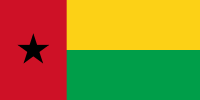 The Republic of Guinea-Bissau (pronounced /ˈɡɪni bɪˈsaʊ/; Portuguese: República da Guiné-Bissau,pronounced [ʁɛˈpublikɐ dɐ ɡiˈnɛ biˈsaw]) is located in West Africa. It is bordered by Senegal to the north, and Guinea to the south and east, with the Atlantic Ocean to its west.
The Republic of Guinea-Bissau (pronounced /ˈɡɪni bɪˈsaʊ/; Portuguese: República da Guiné-Bissau,pronounced [ʁɛˈpublikɐ dɐ ɡiˈnɛ biˈsaw]) is located in West Africa. It is bordered by Senegal to the north, and Guinea to the south and east, with the Atlantic Ocean to its west.
It covers nearly 37,000 square kilometres (14,000 sq mi) with an estimated population of 1,600,000.
Guinea-Bissau was once part of the kingdom of Gabu, part of the Mali Empire; parts of this kingdom persisted until the eighteenth century, while others were part of the Portuguese Empire. It then became the Portuguese colony of Portuguese Guinea in the 19th century. Upon independence, declared in 1973 and recognised in 1974, the name of its capital, Bissau, was added to the country’s name to prevent confusion with the Republic of Guinea.
Only 14% of the population speaks the official language, Portuguese. 44% speak Kriol, a Portuguese-based creole language, and the remainder speaks native African languages. The main religions are Islam and African traditional religions.
It is a member of the African Union, Economic Community of West African States, Organisation of the Islamic Conference, the Latin Union, Community of Portuguese Language Countries, La Francophonie and the South Atlantic Peace and Cooperation Zone.
The earliest overseas contacts came in the 15th century with the Portuguese, who imported slaves from the Guinea area to the offshore Cape Verde Islands. Portuguese control of Guinea-Bissau was marginal despite their claims to sovereignty there. The end of the slave trade forced the Portuguese inland in search of new profits. Their subjugation of the interior was slow and sometimes violent; it was not effectively achieved until 1915, though sporadic resistance continued until 1936.
Guerrilla warfare in the 1960s led to the country’s independence in 1974, but political turmoil continued, and the government was overthrown by a military coup in 1980. A new constitution was adopted in 1984, and the first multiparty elections were held in 1994. A destructive civil war in 1998 was followed by a military coup in 1999, but the coup was followed by elections. A bloodless coup in 2003 was also followed by elections.
The population of Guinea-Bissau is ethnically diverse and has many distinct languages, customs, and social structures. Guinea-Bissauans can be divided into the following ethnic groups: Fula and the Mandinka-speaking people, who comprise the largest portion of the population and are concentrated in the north and northeast; the Balanta and Papel people, who live in the southern coastal regions; and the Manjaco and Mancanha, who occupy the central and northern coastal areas. Most of the remainder are mestiços of mixed Portuguese and African descent, including a Cape Verdean minority.
Portuguese natives comprise a very small percentage of Guinea-Bissauans. This deficit was directly caused by the exodus of Portuguese settlers that took place after Guinea-Bissau gained independence. The country has also a tiny Chinese population, including those of mixed Portuguese and Chinese ancestry from Macau, a former Asian-Portuguese colony.
Guinea-Bissau is one of the world’s poorest nations. Farming and fishing are the leading occupations; cashew nuts are the main cash crop, and rice, corn, beans, cassava, and cotton are grown for domestic use. The country’s mineral resources, including phosphates, bauxite, granite, and limestone, are largely unexploited; however, prospecting for offshore petroleum deposits has begun. Industrial activity is mostly limited to the processing of agricultural products. Cashew nuts are by far the largest export; fish, seafood, peanuts, palm kernels, and timber are also exported. Imports include foodstuffs, machinery, transportation equipment, and petroleum products.
The nation’s location has also made a major transshipment point for the illegal drug trade from Latin America to Europe and the Middle East. The main trading partners are India, Italy, Senegal, Nigeria, and Portugal.
Notes from Wikipedia and Answers.com









